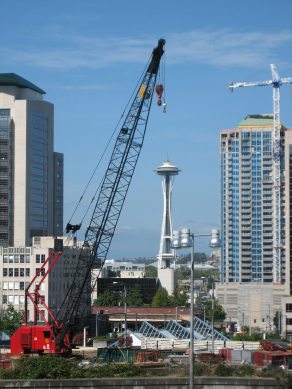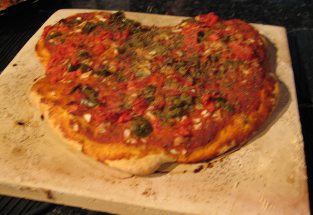Monthly Archives: September 2006
Too Much Coffee Man, the Opera
When I was in Portland, I kept hearing about Too Much Coffee Man, the Opera. I don’t really know what’s going on with it, but it seems interesting.

Pay attention to the subtitles while you’re watching the flash (ugh) cartoon.
Schneier on Security: Human/Bear Security Trade-Off
Bruce Schneier has a blog post that talks about trashcan usability in terms of finding the right balance between security and ease of use: Human/Bear Security Trade-Off
From the blog post, ending with one of the best quotes ever:
Back in the 1980s, Yosemite National Park was having a serious problem with bears: They would wander into campgrounds and break into the garbage bins. This put both bears and people at risk. So the Park Service started installing armored garbage cans that were tricky to open — you had to swing a latch, align two bits of handle, that sort of thing. But it turns out it’s actually quite tricky to get the design of these cans just right. Make it too complex and people can’t get them open to put away their garbage in the first place. Said one park ranger, “There is considerable overlap between the intelligence of the smartest bears and the dumbest tourists.”
Take a look at the comments on the post where all manner of clever and cynical comments add to the post.
The Vintage Mac Museum
Adam Rosen has put together a great online Vintage Mac Museum, where you can learn all about the history of our Apple hardware. Adam is very knowledgable about the history of the Macintosh, and has some great info.
This brings to mind all of the Macintoshes I’ve owned (or used for work):
- (Fat) Mac 512k
- Macintosh SE (with 20MB HD – woohoo!)
- Macintosh SE/30
- Mac IIx (with the Texas Instrument LISP chip in it)
- Mac Classic (color)
- Duo 280 (where I installed my own internal modem, the Mac equivalent of neurosurgery at the time)
- NeXT slab (that counts now, doesn’t it?)
- Powerbook 540 (Blackbird?)
- Mac IIsi
- Quadra and Performas (many different ones, all similar)
- A large, Macintosh-less gap that could be called the dark ages.
- Powerbook G4
- G5 tower
- MacBookPro
And there are probably at least a few more I’m forgetting.
IDEA 2006 – October 23-24 in Seattle
If I could only stay in Seattle another month, I’d certainly be attending the IDEA 2006 Conference (Information: Design, Experience, Access.) going on at the Seattle Public Library, October 23-24, 2006.
From the conference blog:
IDEA 2006 brings together a diverse set of designers, creators, and researchers addressing a fundamental challenge we’re facing today – how to let everyday people take true advantage of the overwhelming mass of information that floods their lives.
There are currently many different kinds of folks working in this space, but they typically don’t talk with one another. For this event, we’ve made an effort to invite presenters across a stunning array of disciplines – museum design, information visualization, librarians, environmental design, user research, engineering, interaction design, product strategy, and more.
It’s important to recognize that this is not airy-fairy theoretical stuff. These presenters are practitioners, people actually doing this cross-channel, cross-media work with complex information. A primary goal of this conference is to give you the confidence to cross boundaries and engage with a wide range of problems.
So if you want to find out where the world of design and information is heading, and how you can prepare, come join us October 23-24 in Seattle.
Just because I can’t make it, doesn’t mean you shouldn’t go. What are you waiting for? Register for IDEA 2006 right now!
Call for Papers – Special Issue of the Journal of Web Engineering
Along with my colleagues and co-guest editors Jim Jansen, Kirstie Hawkey, Melanie Kellar, and Andy Edmonds, I am happy to announce a call for paper submissions for a Special Issue of the Journal of Web Engineering focusing on Logging Traces of Web Activity.
People are now using the World Wide Web (Web) to seek, gather, and share information in increasingly complex ways. In order to develop the next generation of Web information systems, we must have an understanding of people’s goals, their context, and their situational aspects. These aspects are difficult, if not impossible, to investigate in laboratory settings. Therefore, researchers must turn to naturalistic studies involving large number of users who may be separated geographically. In these settings, many researchers require logs of user behaviour on the Web to study the interactions of Web users, both with respect to general behaviour and in order to develop and evaluate new tools and techniques. Traces of Web activity are used for a wide variety of research and commercial purposes including user interface usability and evaluations of user behaviour and patterns on the Web. Unfortunately, current tools and processes do not support consistent and detailed studies using logs of user behaviour. As such, there is a duplication of effort, which hampers progress in the field.
This special issue is inspired by the Logging Traces of Web Activity: The Mechanics of Data Collection workshop at the WWW 2006 Conference this May in Edinburgh, Scotland.
Relevant research themes include, but are not limited to:
- Methodologies for data collection (client-side, server-side, proxy-based)
- Collection of browser data (e.g. events, bookmarks, history, and caches)
- Collection of data from users across different browsers
- AJAX-compatible logging systems
- Using mixed data sources for data validation
- Cleaning Web data
- Web data warehousing
- Using Web data for proactive user functionality
- Methods for matching user behaviour to task models
- Qualitative annotation of Web data
Submissions
Submissions should be full length articles. All submissions will be peer reviewed and should describe original research that is not under consideration in any other forum. Please follow the formatting guidelines of the journal. Submissions should be emailed to melanie@cs.dal.ca in PDF format. All questions regarding submissions should be directed to Melanie Kellar (melanie@cs.dal.ca).
Important Dates
Submission Deadline: January 8, 2007
Reviews Due: February 8, 2007
Notification to Authors: February 19, 2007
Final Papers Due: March 19, 2007
Austin IA Fall Social Hour
The UT ASIS&T group is organizing another Fall IA Social Hour this Sunday (Sept. 17th) from 5-7pm at Club deVille.
I’ll be there late, if at all, as I’ll be coming in from Portland.
Photo Caption Challenge – Seattle
If it is good enough for The New Yorker, it’s good enough for me.

Here are two possible captions that come to mind:
- Yes, please do pass the salt.
- OK then. Queen to Knight 6. Checkmate.
Post your caption as a comment.
Seattle & Portland this week
I am in Seattle this week for the Seattle Innovation Symposium, where academics and industry are working together to understand and distribute the innovation. I will also be talking with some of the smart people at Microsoft about the OpenChoice project: a platform for Web Content Classification & Filtering that I’m working on with many others at UT.
I have already been in town a day and half. I’ve been enjoying the nice weather (no, that’s not a Seattle rain joke) and the downtown area. Yesterday I hit Dilettante Chocolates and walked down to the Pike Place Market for some fresh crab cocktail and hot french bread (a tasty sandwich indeed) at the waterfront park. Then a trip over to the Space Needle and the Experience Music Project (museum) and ran smack dab into a Star Trek convention (no, that’s not a Seattle geek joke). Then somehow I ended up at REI, which seems inevitable here in town (yes, that is a Seattle treehugger joke).
Later in the week, I’m driving down to Portland and will plan on at least one Lewis & Clark related stop, but am open to any road trip recommendations or must-sees in Portland. (I’ve never been to Oregon and I’m happy to correct that error. Also, that’s one more state I can say I’ve been to.)
Labor Day means Pizza
I’ve been working through Peter Reinhart’s book American Pie: My Search for the Perfect Pizza and working on my own quest for perhaps not the perfect pizza, but some very passable options I could make myself.
With Labor Day freeing up a little more time, I tried out two batches of pizza dough. This time I pitted two different flours against each other, with the constant of the bread machine as the dough prep system. (If it is possible to get passable dough from a home machine is a bigger test indeed.)
The first batch came out pretty good, but was perhaps a little heavier than expected, perhaps from the fresh basil and dried oregano I minced and mixed in with the dough. Here’s what I came up with (I forgot to get a picture before I started to cut up the pie):

While this pie was quite tasty, the key wasn’t the dough, it was the roasted red and yellow peppers (not hatch chiles, just peppers this time). If it looks a bit odd, note that I forgot to buy some cheese, but the majority of the time I don’t like most cheeses on pizza anyway.
The second dough batch was with a “bread flour” that I also partly sifted. I also tweaked my recipe by adding about 1/4 tsp. more EVOO. This time I added just a bit of dried oregano and some rosemary to the dough, but much less overall than the spices from the previous batch.
Here’s what I came up with, forgive the oddlly-shaped final form:

The key to this one? Chopped jalepenos and more fresh rosemary with slightly over-ripe roma tomatoes. Tasty. I also have to improve my abilities to evenly distribute toppings. The dough was definitely better, lighter and cooked just a bit better on this other pizza stone.